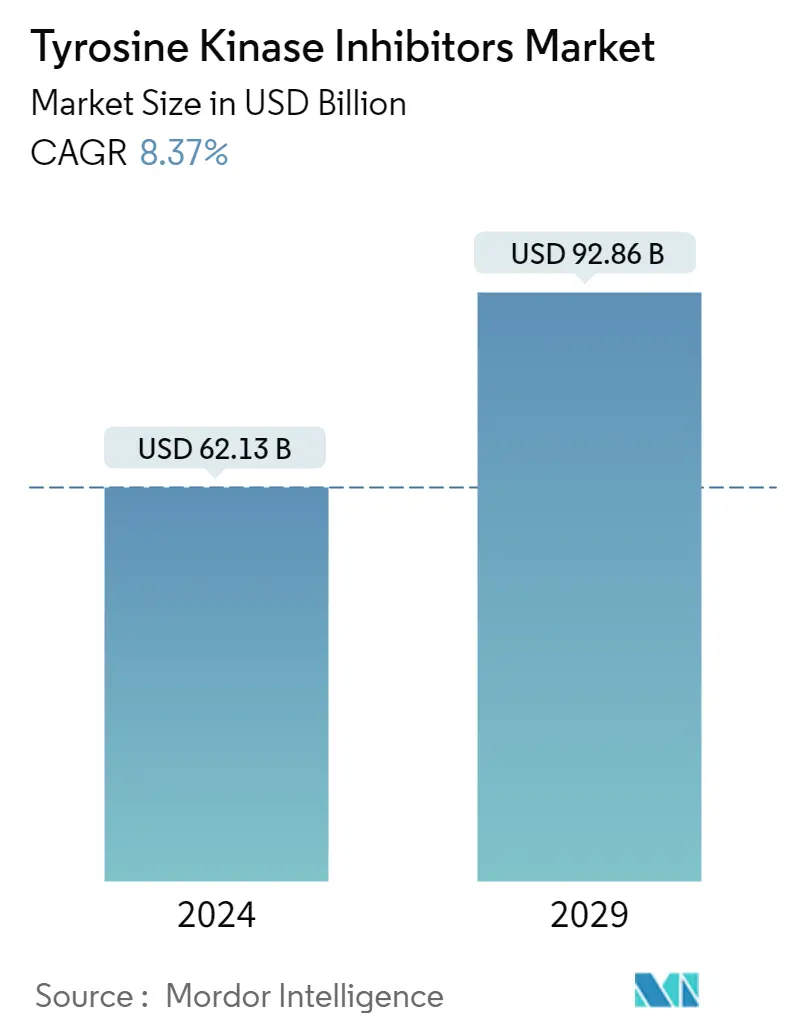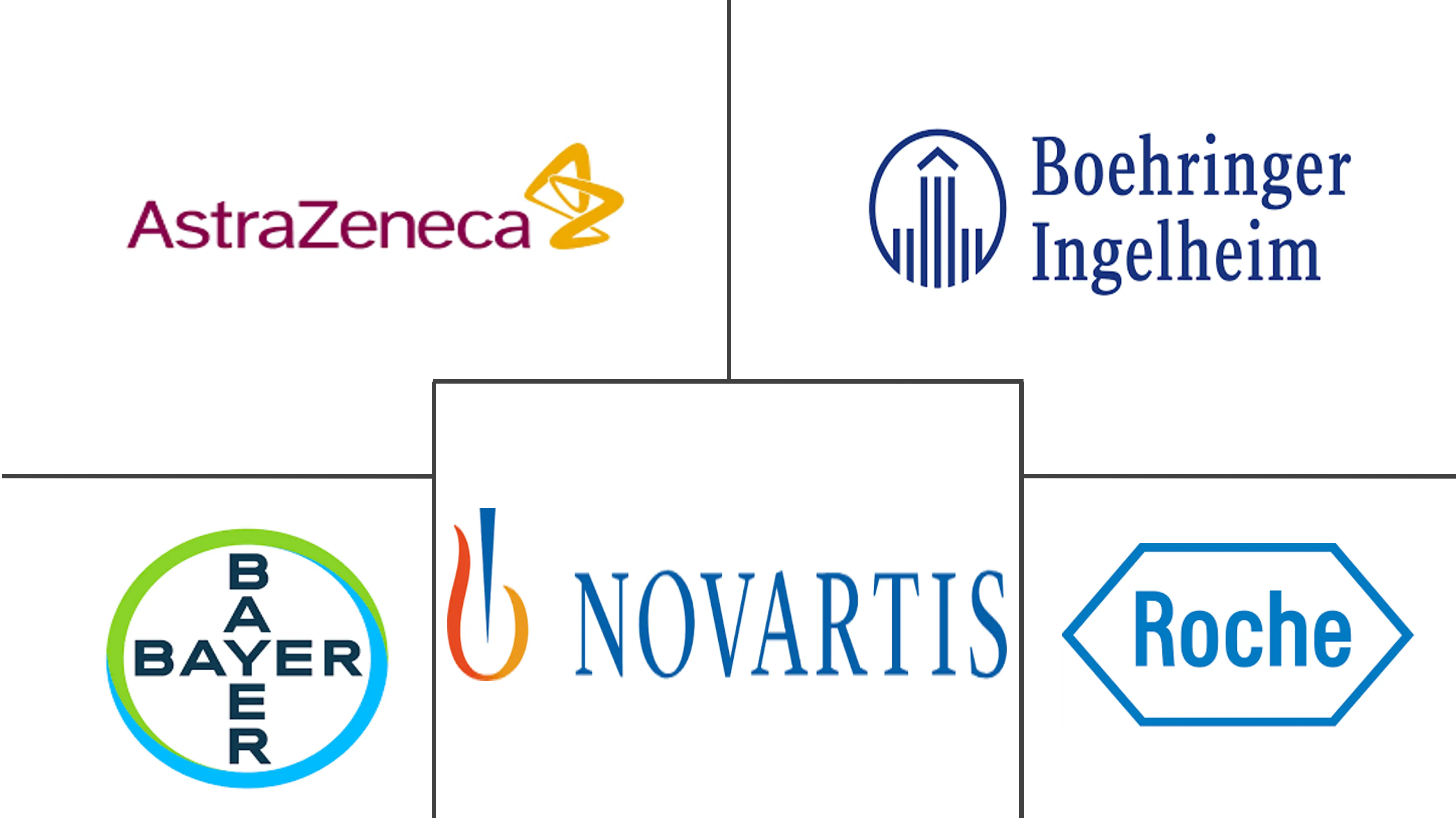Market Size of Tyrosine Kinase Inhibitors Industry

| Study Period | 2019 - 2029 |
| Market Size (2024) | USD 62.13 Billion |
| Market Size (2029) | USD 92.86 Billion |
| CAGR (2024 - 2029) | 8.37 % |
| Fastest Growing Market | Asia Pacific |
| Largest Market | North America |
Major Players
*Disclaimer: Major Players sorted in no particular order |
Tyrosine Kinase Inhibitors Market Analysis
The Tyrosine Kinase Inhibitors Market size is estimated at USD 62.13 billion in 2024, and is expected to reach USD 92.86 billion by 2029, growing at a CAGR of 8.37% during the forecast period (2024-2029).
The COVID-19 pandemic affected healthcare systems around the world and resulted in the interruption of usual care in many healthcare facilities, exposing vulnerable patients with cancer to significant risks during the early pandemic phase. However, as the pandemic progressed tyrosine kinase inhibitor drugs started to show promising results in COVID-19 patients and there was an increased number of clinical trials. For instance, according to an article published by Frontiers in April 2022, imatinib, a tyrosine kinase inhibitor drug, successfully inhibited cellular tyrosine kinase as well as viral fusion, blocking the COVID-19 virus replication. The source also stated that there were three clinical trials that were underway in different parts of the world to investigate the clinical efficacy of imatinib on COVID-19 patients. Thus, the pandemic had a significant impact on the market growth, however as the pandemic has subsided currently, the studied market is expected to have stable growth during the forecast period of the study.
Factors such as the increasing prevalence of cancer, growing research activities, and investment in tyrosine kinase inhibitors are expected to enhance market growth.
The rising prevalence of cancer is a major factor driving the market growth. For instance, as per the report published by the Chinese Medical Journal in March 2022, China is experiencing a greater incidence of cancers. In 2022, ithere were approximately 4,820,000 new cancer cases in China, in which the most common is lung cancer.
Moreover, according to the data published by National Cancer Center Japan in June 2022, an estimated 1,019,000 new cases of cancer were expected in Japan in 2022, out of which 158,200 were new cases of colon/rectum cancer, 132,100 cases of stomach cancer, 128,800 cases of lung/trachea cancer, 96,400 cases of prostate cancer, and 95,000 cases of breast cancer. Thus, the greater incidence of cancers has increased the demand for various tyrosine kinase inhibitor drugs for the treatment of cancers.
Furthermore, the growing research and development activities for tyrosine kinase inhibitors are also expected to boost the market growth. For instance, in August 2022, Theseus Pharmaceuticals, Inc. announced business and pipeline highlights that were focussed on developing next-generation tyrosine kinase inhibitors (TKIs) to outsmart cancer resistance. The company invested USD 7.3 million in the second quarter of 2022, as compared to USD 4.5 million for the same period in 2021. Thus, the growing research activities along with the increasing investments in tyrosine kinase inhibitors are expected to enhance the market growth.
Additionally, the rising developments by major market players are also expected to enhance market growth. For instance, in March 2021, Pfizer Inc. received United states FDA approval for a supplemental New Drug Application (sNDA) for LORBRENA (lorlatinib), a tyrosine kinase inhibitor, expanding the indication to include first-line treatment of people with anaplastic lymphoma kinase (ALK)-positive non-small cell lung cancer (NSCLC). LORBRENA is indicated for adults with metastatic NSCLC whose tumors are ALK-positive as detected by an FDA-approved test.
Thus, the aforementioned factors such as the rising prevalence of cancer, increasing research and development for novel tyrosine kinase inhibitor drugs, and the rising developments by key market players are expected to enhance the market growth. However, the high cost of therapy is expected to hinder market growth.
Tyrosine Kinase Inhibitors Industry Segmentation
As per the scope of the report, a tyrosine kinase inhibitor (TKI) is a pharmaceutical drug that inhibits tyrosine kinases. Tyrosine kinases are enzymes responsible for the activation of many proteins by signal transduction cascades. The Tyrosine Kinase Inhibitors Market is segmented by Type (BCR-ABL Tyrosine Kinase Inhibitor, Epidermal Growth Factor Receptor (EGFR) Tyrosine Kinase Inhibitors, Vascular Endothelial Growth Factor Receptor (VEGFR) Tyrosine Kinase Inhibitors, BRAF Kinase Inhibitors, ROS1 Inhibitors, and Other Types), Application (Chronic Myeloid Leukemia (CML), Lung Cancer, Breast Cancer, Renal Cell Cancer, and Other Applications), and Geography (North America, Europe, Asia-Pacific, Middle East and Africa and South America). The market report also covers the estimated market sizes and trends for 17 different countries across major regions globally. The report offers the value (in USD million) for the above segments.
| By Type | |
| BCR-ABL Tyrosine Kinase Inhibitor | |
| Epidermal Growth Factor Receptor (EGFR) Tyrosine Kinase Inhibitors | |
| Vascular Endothelial Growth Factor Receptor (VEGFR) Tyrosine Kinase Inhibitors | |
| Other Types |
| By Application | |
| Chronic Myeloid Leukemia (CML) | |
| Lung Cancer | |
| Breast Cancer | |
| Renal Cell Cancer | |
| Other Applications |
| Geography | ||||||||
| ||||||||
| ||||||||
| ||||||||
| ||||||||
|
Tyrosine Kinase Inhibitors Market Size Summary
The tyrosine kinase inhibitors market is poised for significant growth over the forecast period, driven by the increasing prevalence of cancer and advancements in research and development. The market is expected to expand as a result of the rising incidence of various cancers, such as lung and breast cancer, which has led to a heightened demand for tyrosine kinase inhibitor drugs. The COVID-19 pandemic initially disrupted healthcare services but later highlighted the potential of these inhibitors in treating COVID-19, leading to increased clinical trials and research activities. This has contributed to the market's resilience and anticipated growth. Key players in the industry are actively investing in the development of next-generation inhibitors, further propelling market expansion.
North America is expected to be a significant contributor to the market's growth, supported by a well-structured healthcare system and substantial investments in cancer research. The region's high cancer incidence rates have led to increased usage of tyrosine kinase inhibitors, driving market demand. Additionally, the emergence of new players in the Asia-Pacific region is contributing to the market's expansion. Despite the high cost of therapy posing a challenge, the market remains moderately fragmented, with major players like Bayer, Boehringer Ingelheim, and AstraZeneca leading the way. Regulatory approvals for new treatments in Europe and ongoing developments by key market players are expected to further enhance market growth.
Tyrosine Kinase Inhibitors Market Size - Table of Contents
-
1. MARKET DYNAMICS
-
1.1 Market Overview
-
1.2 Market Drivers
-
1.2.1 Increasing Prevalence of Cancer
-
1.2.2 Growing Research Activities and Investment in Tyrosine Kinase Inhibitors
-
-
1.3 Market Restraints
-
1.3.1 High Cost of Therapy
-
-
1.4 Porter's Five Forces Analysis
-
1.4.1 Threat of New Entrants
-
1.4.2 Bargaining Power of Buyers/Consumers
-
1.4.3 Bargaining Power of Suppliers
-
1.4.4 Threat of Substitute Products
-
1.4.5 Intensity of Competitive Rivalry
-
-
-
2. MARKET SEGMENTATION (Market Size by Value - USD Million)
-
2.1 By Type
-
2.1.1 BCR-ABL Tyrosine Kinase Inhibitor
-
2.1.2 Epidermal Growth Factor Receptor (EGFR) Tyrosine Kinase Inhibitors
-
2.1.3 Vascular Endothelial Growth Factor Receptor (VEGFR) Tyrosine Kinase Inhibitors
-
2.1.4 Other Types
-
-
2.2 By Application
-
2.2.1 Chronic Myeloid Leukemia (CML)
-
2.2.2 Lung Cancer
-
2.2.3 Breast Cancer
-
2.2.4 Renal Cell Cancer
-
2.2.5 Other Applications
-
-
2.3 Geography
-
2.3.1 North America
-
2.3.1.1 United States
-
2.3.1.2 Canada
-
2.3.1.3 Mexico
-
-
2.3.2 Europe
-
2.3.2.1 Germany
-
2.3.2.2 United Kingdom
-
2.3.2.3 France
-
2.3.2.4 Italy
-
2.3.2.5 Spain
-
2.3.2.6 Rest of Europe
-
-
2.3.3 Asia-Pacific
-
2.3.3.1 China
-
2.3.3.2 Japan
-
2.3.3.3 India
-
2.3.3.4 Australia
-
2.3.3.5 South Korea
-
2.3.3.6 Rest of Asia-Pacific
-
-
2.3.4 Middle East and Africa
-
2.3.4.1 GCC
-
2.3.4.2 South Africa
-
2.3.4.3 Rest of Middle East and Africa
-
-
2.3.5 South America
-
2.3.5.1 Brazil
-
2.3.5.2 Argentina
-
2.3.5.3 Rest of South America
-
-
-
Tyrosine Kinase Inhibitors Market Size FAQs
How big is the Tyrosine Kinase Inhibitors Market?
The Tyrosine Kinase Inhibitors Market size is expected to reach USD 62.13 billion in 2024 and grow at a CAGR of 8.37% to reach USD 92.86 billion by 2029.
What is the current Tyrosine Kinase Inhibitors Market size?
In 2024, the Tyrosine Kinase Inhibitors Market size is expected to reach USD 62.13 billion.

